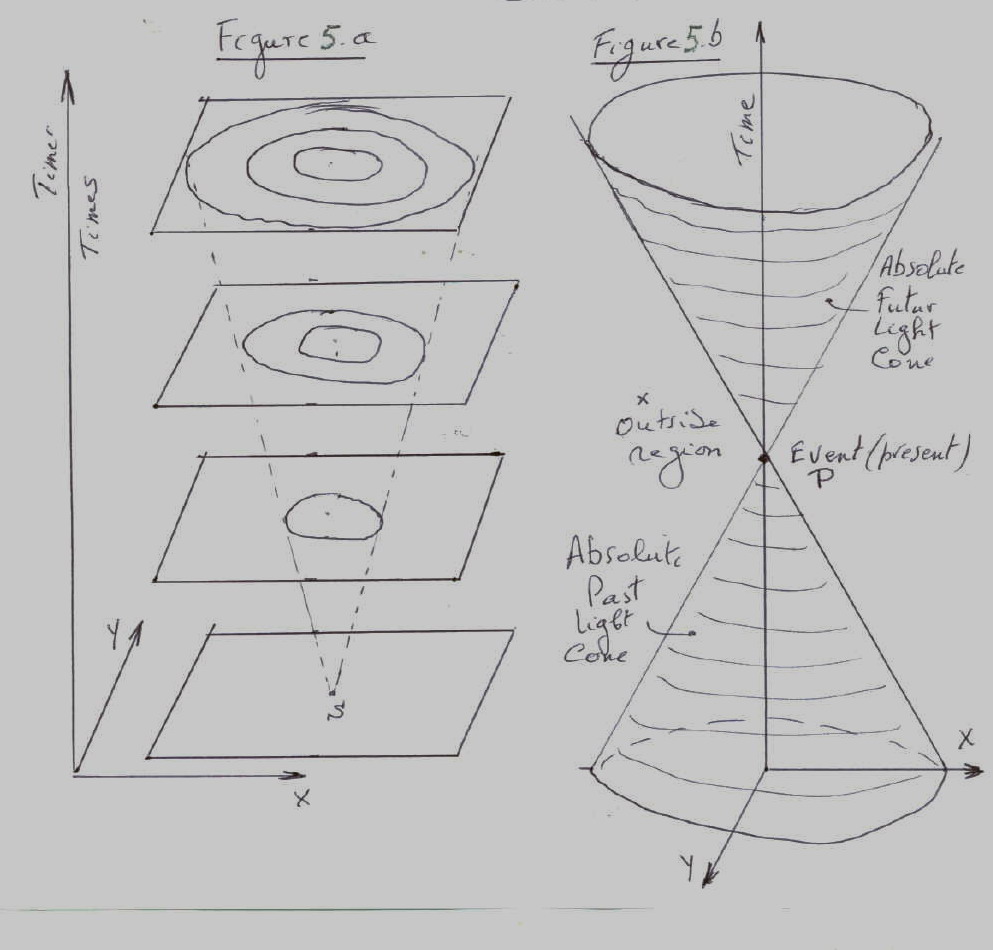It is not possible to make a full and correct graphical representation of a four-dimensional space-time diagram. We can only make partial representations.
8.1 Two-dimensional space diagram only
These are the easier to draw. We will give two examples:
- A plane is the simple one. If we draw two axis, X and Y that intersect
each other at 90 degrees, the position of each point in the plane can be
identified by two number x and y.
- Equally the position of any point on the surface of a sphere can be identified
by two coordinates, its longitude and its latitude.
8.2 Two-Dimensional Space-Time
Such a space-time is represented figure 4. In this case we have the usual X-Y diagram with the only linear dimension indicated on the horizontal OX axis, and the time on the vertical OY axis.
Let us consider two points A and B in space on the surface of two stars five light-years away from each other for example. At time "0" we send a light pulse from A towards B. The light pulse will reach B five years later when the star B is in B'. The light trajectory is then AB' as it takes 5 years to go there.

8.3 Three dimensional space-time

If one throws a stone in a pond in a point S, the waves spread as growing circles with time. If we want to represent it in three dimensions -the two-dimensional surface of the water and the time dimension- then we have the cone represented in Figure 5a.
In the same way, a light pulse originating in S will spread within a three dimensional cone called the future light cone; conversely, the past light cone is the space from which a pulse of light can reach the event (figure 5.b). (If a pulse of light is sent out from a given point in space at a given time then, with time, it spreads out as a sphere.)
The past and future light cone of the event (figure 5.b) delimitates four
regions:
- The absolute future of the event P is inside the future light cone of
P. In it there are all the events that can be affected by what happens at
P.
- The absolute past of the event P is inside the past light cone of P. In
it there are all the possible signals travelling at or below the speed of
light that can affect P.
- Events outside the light future cone of P and above the x-y plane cannot
be affected by what happens at P.
- Events outside the past light cone of P and below the x-y plane cannot
affect what happens at P.
If what is happening at a given time inside the past light cone of P is known, one can calculate what will happen at P.
As an example, let us assume that the sun "dies" (does not emit light anymore) at time 0. As shown in figure 6, the earth will not be affected immediately because it lies outside the future light cone of the sun. However after 8 minutes, the time it takes for the sunrays to reach the earth, the earth enters into the future light cone of the sun and darkness covers the earth. The same thing would happen if we were looking at the light from the stars. This means that when we look at the universe we see it as it was in the past.


If, as Einstein did at first, one ignores the gravitational effect, one
in fact enters the field of the Special Theory of Relativity. For every
event in space-time we can draw a light cone. As the speed of light is constant,
all these light cones are the same and are pointing in the same direction.
As nothing can travel faster that light, then the path of any body travelling
in space-time is a straight line inside its light cone Figure 7).
The Newtonian theory of gravity says that objects attract each other with
a force directly proportional to their masses and inversely proportional
to the square of the distance separating them. If we move one object, the
force would change immediately. That would mean that gravitational forces
travel with a infinite velocity, and this is contrary to the Special Theory
of Relativity that states that nothing can travel faster that the finite
speed of light.